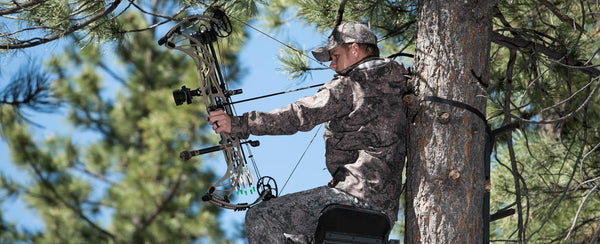Archery Hunting Clothing
Jan 29, 2018
The days of having limited choices when it comes to selecting archery hunting clothing are long gone. I grew up in the era of blue jeans and heavy cotton jackets that accompanied most hunters in their hunting exploits. Hunting apparel back than was heavy, had poor insulation, very little performance, and was usually faced off with rudimentary camo patterns which provided very poor concealment. Over the last couple decades the advancements in concealment technology, and performance fabrics have reached unparalleled heights, and hunters and outdoorsmen around the globe are the beneficiary of these amazing advancements.
With so many choices of hunting clothing to choose from, what constitutes high quality hunting apparel? This is a pretty broad question and really depends on what type of hunting you will be doing, but generally speaking you want to select camo clothing that is light weight, provides concealment consistent with the habitat where you hunt, and has a heap of performance qualities and features we have come to expect in our gear. This article is a basic exploration of the features you want to look for when selecting quality hunting camo.
Don't Sacrifice Performance For Lighter Gear
SKRE Gear® is designed to be light weight while still maintaining the comfort, concealment, and performance you need for a successful hunt.
Shop Light Weight Camo Bundles
Light Weight Hunting Clothing
I don't think there is a hunter alive that wants to pack more weight than they need to, unless it's a heavy pack full of wild protein and adorned with antlers. Success is the name of the game here and any successful hunter will agree that bulky, heavy clothing is not going to increase your chances of success. The last thing an archery hunter needs, is bulky clothing with excessive folds certain to come in contact with a loaded bow string.
Technology is a wonderful thing and the modern day hunter is the beneficiary of such wonderful advancements. As you begin your quest for new gear, you'll will discover that most of your top end camo hunting clothing is crafted with light weight performance fabrics that provide excellent insulation and breathability at a fraction of the weight.
Micro-fleece, for example, provides a great insulation and wind barrier and weights virtually nothing. Bonding a micro fleece liner to a durable soft-shell face fabric, makes for a great combination when crafting light weight jackets and insulation layers. Furthermore, advancements in apparel hardware like zippers, cord locks, and buckles are not only smaller and lighter, but are very durable. If your hunting exploits take you deep in the backcountry, having light weight gear will assist you in extending your trips thus increasing your odds of success.
Hunting Camo, The Science of Concealment
Yea, I've heard the old timer adage " I can kill the biggest buck in the woods wearing a flannel shirt and blue jeans." I can't, and won't argue that success can be had even wearing a loin cloth and using a spear, but honestly how often do you see an archery hunter packing out a big buck in a flannel shirt and blue jeans. It certainly isn't the norm where I hunt.
I think we can all agree that multiple shades of earth tone colors will provide better break up of a human outline than would a solid color. It would also stand to reason, certain combinations of earth-tone colors with a combination of organic shapes are more effective at concealment than say another combination. I don't want to bore anyone to tears, but their is some serious science behind effective concealment.
There is a lot more to concealment than a random placement of shapes and colors. There is a reason the top militaries around the world spend large sums of money on concealment research. In combat situations concealment can determine the outcome in a life or death situation. To say advancements in concealment have revolutionized the industry would be a gross understatement. In order to understand the difference between concealment patterns that are effective and ones that are not, you need to grasp some basic science behind modern concealment technology.
Diving into the Science

The world we live in is made up of geometric shapes known as fractals. A Fractal tends to repeat at larger or smaller scales within the same object. A twig is a small version of a branch which can be a small version of a parent branch which is a small version of the tree trunk. A twig close up may resemble the tree trunk at a distance and only size separates the two, if no reference to scale is provided the two may be indistinguishable from each other.
In the past, Camouflage design has been a semi random placement of color and shape to disrupt the targets true shape, or camouflage patterns have attempted to mimic natural camouflage, in both cases these designs actually go too far in random patterns or specific mimicry to provide a better camouflage.
We see fractals in many forms, snowflakes, rocks, trees, mountains, brush, clouds. Our subconscious actually notices these fractal shapes and once the brain has identified them as natural and commonplace in particular settings it retains those shapes. When the visual part of the brain analyzes a setting it quickly notes the common fractals it’s seen in the past and ignores them, treating them as background noise – not something which requires further scrutiny.
If the pattern is not a fractal – such as a random placement of blobs, it may in-fact stand out to the visual system. If the fractal is a lake shape fractal in a woodland setting, again the subconscious will note that something is out of place. What we attempt to do with fractal camouflage is to merge these common shapes with the correct background and then scale them to the appropriate size to properly disrupt the shape of the target.
Fractal concealment is not about duplicating nature, but designing from the aspect of target shape, size, scale, operational environment, vision science, geometrics, algorithms, static or mobile and color science. It really is rocket science. Aside from military applications, I know of one hunting apparel company that effectively uses fractal algorithms in their concealment designs: SKRE gear. SKRE offers hunters two patterns, Summit and MTN-Stealth. Both patterns span the concealment gap and are effective in multiple habitat environments. Their gear is top notch and should be a top consideration.
Don't Sacrifice Performance For Lighter Gear
SKRE Gear® is designed to be light weight while still maintaining the comfort, concealment, and performance you need for a successful hunt.
Shop Light Weight Camo Bundles
Performance
In the good old days, the words hunting clothing and performance were likely never used in the same sentence. Most the old timers had one heavy jacket or slicker usually made of cotton or canvas. The only layer under that was a heavy wool or cotton flannel shirt. While most these jackets were durable and provided some insulation, they had almost no other performing qualities. Times have certainly changed since those days, and thanks to advancements in performance textiles we can have our cake and eat it too. The list of performance qualities is long, but there are a few shinning stars like breathability, and the ability to shed water that rank high on that list.
The ability to wick moisture away from your body lends to unimpeded thermal regulation. We call this breathability. You want fabrics that are very breathable. When you hike, you sweat. If that moisture can't escape, you are going to overheat quickly. If you can't maintain a healthy core temperature your going to wear down quicker, which doesn't bode well for extending your time in the field.
There are a lot of natural and synthetic fabrics out there that are breathable, but proceed with caution. Just because a promotional tag states a jacket is breathable doesn't mean it is. Some manufactures list breathability ratings but the testing used to generate those numbers are not standardized which makes those ratings unreliable and nothing more than a promotional tool to convince you to buy.
Frankly, one of the quickest ways to dump heat is through ventilation zippers. This is one of my favorite features on my hunting jacket and pant. A great hunting jacket will have armpit zippers to quickly dump heat. My go to jacket and pant is the hardscrabble series by SKRE. The hardscrabble jacket has dual armpit zippers, and the hardscrabble pant has dual side vent zippers located on the outer thigh of the pant. These vents allow the user to dump heat quickly when the thermals rise.

Equally important to breathability is the ability of a garment to shed water. There are many hunters who do not understand the difference between water resistant and waterproof. Water resistant garments will shed water up to a certain point and then soak through, while a waterproof garment will shed 100% water.
A lot of the cheaper brands of camo clothing have zero water repellency, while many of the more quality brands will have DWR (Durable Water Repellant), which is a water resistant treatment applied to the face fabric. If you look at the hang tags on a garment, it should disclose DWR if it's been applied. A very large percentage of Hunting clothing will have some type of DWR.
DWR treated clothing is great for shedding moisture and should keep you dry unless you get into a torrential down pour. My hardscrabble jacket is treated with Teflon DWR and is my go to jacket for 90% of the hunting I do. In contrast, garments labeled waterproof are rated to shed water 100%. Most rain gear is rated as 100% waterproof. Waterproof garments usually have every seam sealed with seam tape or welded. Many of the more expensive brands have a waterproof barrier. All the zippers must be waterproof or the garment will leak. YKK zippers are gold standard in the industry and are found on most top end brands. A 10000/24hr or 20000/24hr rated barrier is the industry standard and will keep you dry in the heaviest down pours.
I use the Nebo Rain jacket and pant. Each item weighs less than 14 ounces and packs down to the size of a nalgene bottle. My Nebo rain pants have full length YKK Aquaguard waterproof zippers which allow me to slip them on and off without removing my boots. Features that allow you to focus more on the hunt and less on your gear is essential when you are shopping for new camo.
Durability
Durability needs to be at the front of the line, when it comes to purchasing new camo, and price is not always an indicator of quality. I have had some pretty expensive hunting apparel fail me when I needed it the most. To determine if a brand is durable, the best source is other hunters.
Jump on hunting forums and read reviews and customer experiences. Ask fellow hunters about their experiences with the brand they are wearing. Most hunters will shoot you straight. When you settle on a choice, have realistic expectations. I don't care what any one tells you, apparel is not bullet proof. Even the toughest materials are prone to snags, rips and tears when they contact sharp objects.
Choose a brand that provides excellent customer service, and will take care of you if you encounter a manufacture defect. I have personally observed the manufacturing process and every stitch and every process of construction has a human element to it. Don't be too quick to write a company off if you encounter a manufacture defect. While defects represent a small percentage of inventory, they exist in every brand.

There is a lot to digest in this article, and consequently the coverage on each topic was very basic. I suggest doing your own due diligence and selecting gear that is right for you. Don't feel like you have to check all the boxes when purchasing new hunting camo. However, the advice and information provided in this article should be carefully considered as you make your final selection.
Quality hunting clothing will allow you to hunt harder and longer and we hope will leave you standing at the end of many short blood trails. So make sure to shop SKRE Gear and set yourself with some of the best hunting clothes on the market!




